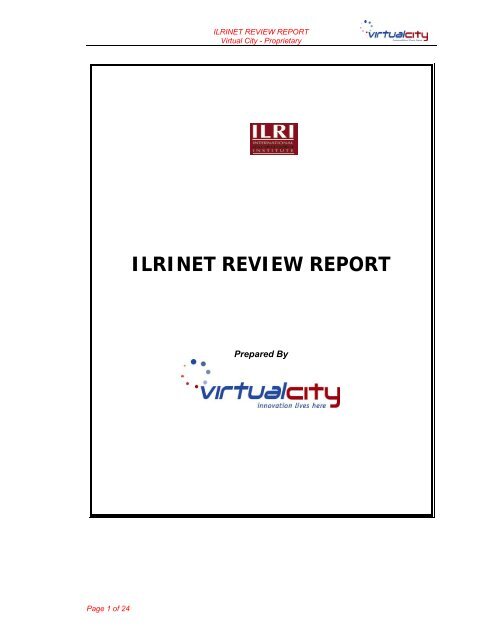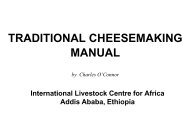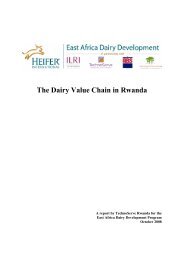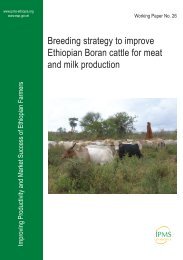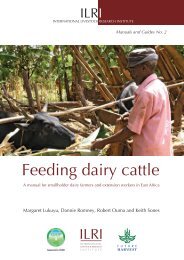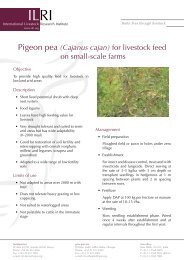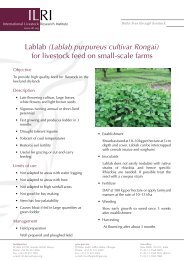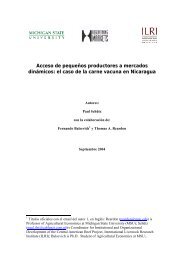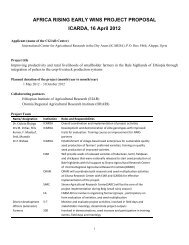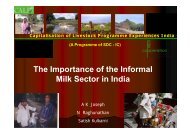ilrinet review report - International Livestock Research Institute (ILRI)
ilrinet review report - International Livestock Research Institute (ILRI)
ilrinet review report - International Livestock Research Institute (ILRI)
You also want an ePaper? Increase the reach of your titles
YUMPU automatically turns print PDFs into web optimized ePapers that Google loves.
Page 1 of 24<br />
<strong>ILRI</strong>NET REVIEW REPORT<br />
Virtual City - Proprietary<br />
<strong>ILRI</strong>NET REVIEW REPORT<br />
Prepared By
Page 2 of 24<br />
<strong>ILRI</strong>NET REVIEW REPORT<br />
Virtual City - Proprietary<br />
TABLE OF CONTENTS<br />
1.0 Executive Summary............................................................................................ 3<br />
2.0 Background ......................................................................................................... 4<br />
3.0 <strong>ILRI</strong>NET Introduction .......................................................................................... 5<br />
3.1 <strong>ILRI</strong>NET History ......................................................................................................... 5<br />
3.2 Services of <strong>ILRI</strong>NET................................................................................................... 5<br />
3.3 Benefits of <strong>ILRI</strong>NET ................................................................................................... 5<br />
3.4 Contents of <strong>ILRI</strong>NET.................................................................................................. 5<br />
3.5 <strong>ILRI</strong>NET Technical Platform...................................................................................... 6<br />
4.0 <strong>ILRI</strong>NET Consultancy Report............................................................................. 8<br />
4.1 Consultancy Methodology........................................................................................ 8<br />
4.2 <strong>ILRI</strong>NET Strengths ..................................................................................................... 9<br />
4.3 <strong>ILRI</strong>NET Weaknesses .............................................................................................. 10<br />
5.0 <strong>ILRI</strong>NET Recommendations.............................................................................12<br />
5.1 <strong>ILRI</strong>NET Future Model: An Enterprise Information Portal ................................... 12<br />
5.2 Challenges & Solutions for Developing an Enterprise Information Portal......... 16<br />
5.3 A Roadmap toward developing an Enterprise Information Portal ...................... 19<br />
Phase 2 – Design.......................................................................................................................... 20<br />
Phase 3 – Content ........................................................................................................................ 21<br />
Phase 4 – Change and communication ...................................................................................... 21<br />
Phase 5 – Technology.................................................................................................................. 21<br />
6.0 Conclusion.........................................................................................................23<br />
7.0 Appendices........................................................................................................24
1.0 Executive Summary<br />
Page 3 of 24<br />
<strong>ILRI</strong>NET REVIEW REPORT<br />
Virtual City - Proprietary<br />
Started in 1999, Virtual City has grown from humble beginnings as a Web service company to one of<br />
the region’s leaders in the development, implementation and management of Electronic Commerce,<br />
Mobile Commerce and Knowledge Management Systems. Virtual City’s Knowledge Management<br />
Solutions comprise of customized software systems that enable customers to create, publish, read and<br />
search information electronically across a company.<br />
Virtual City was contracted by the <strong>International</strong> <strong>Livestock</strong> <strong>Research</strong> <strong>Institute</strong> (<strong>ILRI</strong>), to evaluate the<br />
organization’s intranet (referred to as <strong>ILRI</strong>NET), and come up with recommendations on how to<br />
improve the services provided by the platform. This would then enable <strong>ILRI</strong>’s staff to carry out their<br />
work more effectively and to communicate and collaborate with colleagues and peers independent on<br />
where they are located in the world.<br />
The consultancy was conducted over a period of eight and a half days in the <strong>ILRI</strong> campuses in Addis<br />
Ababa, Ethiopia and in the Nairobi, Kenya. A number of staff from a variety of departments in <strong>ILRI</strong> were<br />
interviewed and the results of the interviews have been used to form the basis of this <strong>report</strong>.<br />
The <strong>report</strong> first gives a small background on <strong>ILRI</strong>NET then highlights its strengths and weaknesses. It<br />
then goes on to give a set of recommendations on how <strong>ILRI</strong>NET can be revamped and revitalized<br />
complete with a roadmap detailing the steps that need to be taken along the way.<br />
In summary, in the space of approximately four years, <strong>ILRI</strong>NET has become an essential and popular<br />
tool in <strong>ILRI</strong> used primarily for communication. <strong>ILRI</strong>NET is also acts as an administrative tool helping<br />
<strong>ILRI</strong> employees perform administrative tasks more effectively. The Partnership and Communication<br />
team and especially the Web Team have done a lot to ensure <strong>ILRI</strong>NET is a widely used and effective<br />
tool within the organization.<br />
<strong>ILRI</strong>NET weaknesses include a lack of policies and systems to ensure focal points (<strong>ILRI</strong>NET users<br />
mandated to update certain sections of the site) are effectively updating the intranet. This has resulted<br />
in a situation where some sections of <strong>ILRI</strong>NET are not regularly updated. The site layout is also not<br />
very user-friendly and takes a while to load especially for users with old computers.<br />
In addressing these and other issues, we recommended the redevelopment of <strong>ILRI</strong>NET with a view<br />
towards making <strong>ILRI</strong>NET a more effective:<br />
• Collaboration tool<br />
• Communications tool<br />
• Gateway into the Knowledge Management systems<br />
• Administrative tool<br />
The revamped <strong>ILRI</strong>NET would be aimed to the main user groups of <strong>ILRI</strong>NET who are;<br />
1) <strong>Research</strong>ers/Scientists<br />
2) Service Staff e.g. Public Awareness department, I.T staff, Finance staff, H.R staff etc<br />
3) Administration staff e.g. seminar/workshop organizers, catering staff, housing staff, engineering<br />
staff etc<br />
The <strong>report</strong> highlights the challenges of revamping <strong>ILRI</strong>NET but it also details suggestions on how these<br />
challenges can be overcome. Finally, <strong>report</strong> also drafts a roadmap that can be used to take <strong>ILRI</strong>NET<br />
from its current state to its desired state.<br />
In order to ensure the success of the future <strong>ILRI</strong>NET, it is imperative that current and future information<br />
systems purchases by <strong>ILRI</strong> have been thoroughly evaluated and vetted to ensure that they can be<br />
quickly and easily extended to <strong>ILRI</strong>NET. This will ensure that <strong>ILRI</strong>NET users have one window of<br />
access to information systems and applications hereby making it easier for <strong>ILRI</strong>NET to fulfil its goals.
2.0 Background<br />
Page 4 of 24<br />
<strong>ILRI</strong>NET REVIEW REPORT<br />
Virtual City - Proprietary<br />
The <strong>International</strong> <strong>Livestock</strong> <strong>Research</strong> <strong>Institute</strong> (www.ilri.org) has a mandate to enhance the well-being<br />
of present and future generations in developing countries through research to improve sustainable<br />
livestock production. It works in partnerships and alliances with other organizations, national and<br />
international, in the fields of livestock research, training and information exchange. <strong>ILRI</strong> was formed in<br />
1994. Its headquarters are in Nairobi, Kenya, with offices in seven more countries around the world.<br />
The <strong>International</strong> <strong>Livestock</strong> <strong>Research</strong> <strong>Institute</strong> (<strong>ILRI</strong>) works at the crossroads of livestock and poverty,<br />
bringing high-quality science and capacity-building to bear on poverty reduction and sustainable<br />
development. <strong>ILRI</strong> works in Africa, Asia and Latin America and the Caribbean, with offices in East and<br />
West Africa, South and Southeast Asia, China and Central America.<br />
<strong>ILRI</strong> is a non-profit-making and non-governmental organization with headquarters in Nairobi, Kenya,<br />
and a second principal campus in Addis Ababa, Ethiopia. The organization employs over 700 staff from<br />
about 40 countries. About 80 staff are recruited through international competitions and represent some<br />
30 disciplines. Around 600 staff are nationally recruited, largely from Kenya and Ethiopia.<br />
Vision<br />
A world made better for poor people in developing countries by improving agricultural systems in which<br />
livestock are important.<br />
Mission<br />
The <strong>International</strong> <strong>Livestock</strong> <strong>Research</strong> <strong>Institute</strong> (<strong>ILRI</strong>) works at the crossroads of livestock and poverty,<br />
bringing high-quality science and capacity-building to bear on poverty reduction and sustainable<br />
development for poor livestock keepers and their communities.<br />
<strong>ILRI</strong> works in partnerships and alliances with other organizations, national and international, in livestock<br />
research, training and information. <strong>ILRI</strong> works in all tropical developing regions of Africa, Asia and Latin<br />
America and the Caribbean.<br />
<strong>ILRI</strong> is one of 15 Future Harvest Centres, which conduct food and environmental research to help<br />
alleviate poverty and increase food security while protecting the natural resource base. The Centres are<br />
funded by government agencies, development banks, private foundations and regional and<br />
international organisations and are supported by the Consultative Group on <strong>International</strong> Agricultural<br />
<strong>Research</strong> (CGIAR).<br />
The CGIAR is an association of public- and private-sector institutions. Its mission is to contribute to<br />
food security and poverty eradication in developing countries through research, partnership, capacity<br />
building and policy support. The co-sponsors of the CGIAR are the World Bank, the United Nations<br />
Development Programme, the Food and Agriculture Organization of the United Nations and the<br />
<strong>International</strong> Fund for Agricultural Development.<br />
Governance<br />
<strong>ILRI</strong> is guided by a board of trustees comprising 12 leading professionals in relevant research,<br />
development and management issues. The institute belongs to the CGIAR, an association of more than<br />
60 governments and public- and private-sector institutions supporting a network of 15 agricultural<br />
research centres working to reduce poverty, hunger and environmental degradation in developing<br />
countries.
3.0 <strong>ILRI</strong>NET Introduction<br />
3.1 <strong>ILRI</strong>NET History<br />
Page 5 of 24<br />
<strong>ILRI</strong>NET REVIEW REPORT<br />
Virtual City - Proprietary<br />
<strong>ILRI</strong>NET was created and launched in 2003 and is the first institutional Intranet of the <strong>International</strong><br />
<strong>Livestock</strong> <strong>Research</strong> <strong>Institute</strong> (<strong>ILRI</strong>). It was produced to improve internal communications within the two<br />
main <strong>ILRI</strong> campuses in Nairobi (Kenya) and Addis Ababa (Ethiopia), and other satellite branches in the<br />
rest of the world.<br />
<strong>ILRI</strong>NET has been very effective as an organizational Intranet because it has been able to effectively<br />
combine three attributes of effective Intranets i.e. creating self-service tools, organizational<br />
communication and information sharing. The Intranet is arguably the best one in the region and ranks<br />
highly compared to Intranets all over the world. The Web Team has shown a lot of passion, dedication,<br />
innovation and perseverance in getting <strong>ILRI</strong>NET to where it is know and should be highly commended<br />
for their work<br />
3.2 Services of <strong>ILRI</strong>NET<br />
• Acts as an organizational communication tool helping the organization communicate to its<br />
employees more effectively<br />
• Acts as an administration tool helping <strong>ILRI</strong> staff from both the Nairobi and Addis Ababa<br />
campuses and all over the world gain access to resources for the services sections e.g.<br />
Human Resource documents e.g. Leave forms, policies etc from the Human Resource section,<br />
Information Technology manuals and policies, Finance information etc.<br />
• Assist researchers and scientists gain access to Knowledge Management tools and external<br />
databases through links to CGIAR databases and to the <strong>ILRI</strong> publications in the Infocentre.<br />
3.3 Benefits of <strong>ILRI</strong>NET<br />
• Helps <strong>ILRI</strong> staff stay in touch with what’s happening in the organization.<br />
• Helps the Partnerships and Communications department communicate organizational news,<br />
changes and policies more effectively to <strong>ILRI</strong> staff<br />
• Helps research staff gain access to the latest publications and periodicals in the organization<br />
• Helps research staff gain access to knowledge management tools<br />
3.4 Contents of <strong>ILRI</strong>NET<br />
Content of <strong>ILRI</strong>NET can be split into the following categories:<br />
CATEGORY 1 – INTERNAL COMMUNICATION CATEGORY 2 – RESEARCH<br />
- What’s happening<br />
- Latest posting<br />
- Audio/Video recording<br />
- Events<br />
- Picture of the day<br />
- Announcements<br />
- DDG <strong>Research</strong><br />
- Targeting & Innovations<br />
- Market opportunities<br />
- Biotechnology<br />
- People, livestock, environment<br />
- Infocentre<br />
CATEGORY 3 – ADMINISTRATION CATEGORY 4 – SENIOR MANAGEMENT<br />
- Internal Audit<br />
- HRFA<br />
- HR<br />
- Finance<br />
- I.T<br />
- Travel<br />
- Partnerships & Communication<br />
- Director General’s Office<br />
- Deputy Director Generals Office<br />
- Board of Governors page
3.5 <strong>ILRI</strong>NET Technical Platform<br />
Page 6 of 24<br />
<strong>ILRI</strong>NET REVIEW REPORT<br />
Virtual City - Proprietary<br />
<strong>ILRI</strong>NET has been developed on a number of platforms and is hosted on 2 separate servers.<br />
The main server uses MS Windows Server 2003 as its operating system while the other server uses<br />
Debian Linux as its operating system.<br />
The primary platform which consists of majority of the site and the Content Management System (CMS)<br />
is powered by a Microsoft SQL 2000 database with the application platform as Microsoft Active Server<br />
Pages (ASP). The other major application is called Phprojeckt and runs on a Debian Linux server with<br />
MySQL as its backend database.<br />
The following table lists the major applications running on <strong>ILRI</strong>NET servers<br />
APPLICATION Platform/Database SERVER OS USE<br />
Content<br />
Management<br />
System (CMS)<br />
ASP/MS SQL Windows 2003<br />
Server<br />
Used to manage content on<br />
<strong>ILRI</strong>. Acts as an interface<br />
between the Intranet and<br />
the backend databases.<br />
Focal points are trained on<br />
how to use the CMS in<br />
order to update their<br />
sections of the Intranet<br />
PhProjeckt PHP/MySQL Debian Linux A groupware application<br />
combining web based<br />
email, calendaring, project<br />
management, task<br />
management and other<br />
utilities in one web-based<br />
application. Not actively<br />
used despite it potential for<br />
Public website –<br />
www.ilri.org<br />
ASP/MS SQL Windows 2003<br />
Server<br />
enhancing collaboration<br />
The public website for <strong>ILRI</strong>.<br />
No connection with<br />
<strong>ILRI</strong>NET apart from being<br />
hosted on the same server.<br />
Uses a different Content<br />
Management System than<br />
the one used by <strong>ILRI</strong>NET<br />
Both servers are located in a hosting facility in California, USA. The public website and ten other<br />
websites are also hosted on the servers. Future plans are underway to replicate <strong>ILRI</strong>NET in both the<br />
Nairobi and Addis Ababa campuses ensuring local users in both campuses can access <strong>ILRI</strong>NET<br />
quickly.<br />
<strong>ILRI</strong>NET has over 700 users. Internet Protocol (IP) authentication is used to authenticate users in the<br />
Nairobi and Addis Ababa campuses. Some sections of the site have restricted access for security<br />
reasons. <strong>ILRI</strong> users access <strong>ILRI</strong>NET through a username/password assigned to them by the Web<br />
Team staff.<br />
Every department in <strong>ILRI</strong> has specific people assigned to update content on <strong>ILRI</strong>NET in the context of<br />
their respective departments only. These people (known as focal points) can only add/edit/delete<br />
content pertaining to their respective departments.
Page 7 of 24<br />
<strong>ILRI</strong>NET REVIEW REPORT<br />
Virtual City - Proprietary<br />
Web Team members have full access to all sections of <strong>ILRI</strong>NET apart from restricted areas. The<br />
restricted areas mainly host information on:<br />
• Upcoming Board of Governors meetings. Access is derestricted one the meetings have been<br />
held<br />
• Resource Mobilization information<br />
• Director General’s section<br />
• Finance section<br />
Full access to these areas is limited to Birru Dori (the Web Team head) and focal persons assigned to<br />
that area. The public website uses a different CMS system from <strong>ILRI</strong>NET.<br />
There has been only one case of a hacker gaining access to the public website through a flaw in MS<br />
SQL server. The flaw was immediately patched and security measures put in place to ensure this does<br />
not happen again.
4.0 <strong>ILRI</strong>NET Consultancy Report<br />
Page 8 of 24<br />
<strong>ILRI</strong>NET REVIEW REPORT<br />
Virtual City - Proprietary<br />
Virtual City was contracted by <strong>International</strong> <strong>Livestock</strong> <strong>Research</strong> <strong>Institute</strong> (<strong>ILRI</strong>) to conduct a <strong>review</strong> of<br />
their intranet, <strong>ILRI</strong>NET, and draft a <strong>report</strong> with suggestions on how the Intranet can be improved.<br />
Over the course of a week, the Virtual City team conducted a series of interviews with <strong>ILRI</strong> members of<br />
staff based in Addis Ababa, Ethiopia and Nairobi, Kenya.<br />
4.1 Consultancy Methodology<br />
The Intranet consultancy was initiated with the goals of identifying:<br />
• Issues with the existing Intranet<br />
• Information needs of staff<br />
• Organizational issues and roadblocks impacting on <strong>ILRI</strong>NET usage<br />
• Opportunities for delivering new capabilities and tools<br />
• Key goals for <strong>ILRI</strong>NET<br />
• Concrete roadmap for improving the intranet<br />
These goals all followed a well-tested methodology that recognizes that there are five main aspects of<br />
an intranet that need to be explored:<br />
• Strategy<br />
• Design<br />
• Content<br />
• Change management & communication<br />
• Technology<br />
A questionnaire was then designed based on the well-established SERVQUAL instrument developed<br />
by Parasuraman et al (1985, 1988) using a set of items (dimensions) that reflect a model of perceived<br />
Service Quality. Statements are used to measure expectation and perception (experience) for different<br />
dimensions as shown below:<br />
1. Reliability: Provide accurate information and consistency. <strong>ILRI</strong>NET is dependable with<br />
minimum downtime, content and information is up-to-date and accurate, Intranet look and feel<br />
is user friendly.<br />
2. Responsiveness: Fast Website, easy access and willingness to provide help. E-mail address /<br />
helplines available for support and suggestions, <strong>ILRI</strong>NET response times are fast and reliable,<br />
<strong>ILRI</strong>NET content publishers always open to suggestions.<br />
3. Assurance: Credible information, secure and allows users to inspire trust and confidence.<br />
<strong>ILRI</strong>NET content is appropriate and relative to <strong>ILRI</strong>, the organization policies are accessible.<br />
4. Empathy: Caring communication provides individual attention to users. <strong>ILRI</strong>NET content is<br />
easy to understand, <strong>ILRI</strong>NET is assisting users to collaborate, share and exchange ideas and<br />
also encouraging team building.
Page 9 of 24<br />
<strong>ILRI</strong>NET REVIEW REPORT<br />
Virtual City - Proprietary<br />
5. Tangibles: Appearance of the Intranet site. Information is found with minimum key-clicks, the<br />
Intranet home page is visually appealing and site navigation is consistent.<br />
Those with access to <strong>ILRI</strong>NET in Addis Ababa and Nairobi were the main target of this study. Each<br />
question provided a 5-point scale on which the respondents could assess importance and performance<br />
of different aspects of the service as well as some demographic items to allow for analysis. Overall user<br />
responses are shown in the table below.<br />
Table 1: <strong>ILRI</strong>NET User Perceptions<br />
Reliability<br />
Responsiveness<br />
Assurance<br />
Empathy<br />
Tangibles<br />
User Responses<br />
Positive Comments Criticisms<br />
� <strong>ILRI</strong>NET is dependable, rarely goes down<br />
and in most cases this happens when<br />
Internet connection is down<br />
� Content on some sections such as What’s<br />
new, pic of the day etc is regularly updated<br />
� Web Team responds quickly to user<br />
enquiries, helps focal points update<br />
<strong>ILRI</strong>NET, occasionally updates <strong>ILRI</strong>NET on<br />
behalf of focal points<br />
� Email addresses available to contact Web<br />
Team<br />
� Content on some sections such as What’s<br />
new, pic of the day etc is regularly updated<br />
� <strong>ILRI</strong>NET content is relevant to <strong>ILRI</strong>, does<br />
not contain info on other organizations<br />
(apart from job openings section)<br />
� <strong>ILRI</strong>NET content is relevant to <strong>ILRI</strong>, does<br />
not contain info on other organizations<br />
(apart from job openings section)<br />
� Easy to go to different sections of the<br />
Intranet from the frontpage<br />
� <strong>ILRI</strong>NET is abit hard to use especially when<br />
user is new to the organization<br />
� Not easy to quickly find information with the<br />
current information architecture<br />
� Information on themes in <strong>ILRI</strong>NET is not<br />
consistent with what’s on the public website<br />
� Focal points do not have a lot of flexibility when<br />
they want to change how content appears on<br />
their section, have to liaise with Web Team<br />
� The lack of constant updating on some sections<br />
of <strong>ILRI</strong>NET makes users lose faith in the<br />
accuracy of that content<br />
� As mentioned before, there is a discrepancy in<br />
information on themes in <strong>ILRI</strong>NET and the<br />
public website, people will question why<br />
� <strong>ILRI</strong>NET can do a lot more to enhance<br />
collaboration and communication, only available<br />
tool for collaboration is the groupware<br />
application which is not widely used<br />
� Site navigation can be more intuitive, there are<br />
too many links on the frontpage of <strong>ILRI</strong>NET<br />
(approximately 20). Some links are repeated<br />
e.g. Infocenter, This leads to information<br />
overload.<br />
Analysis on the five service dimensions shows clearly that in most instances user satisfaction is<br />
impressive and above average. The following pages highlight <strong>ILRI</strong>NET’s strengths and weaknesses<br />
pertaining to the above areas and form the basis for the set of recommendations that follow.<br />
4.2 <strong>ILRI</strong>NET Strengths<br />
1) <strong>ILRI</strong>NET Usage<br />
Due to various factors primarily constant email updates sent to <strong>ILRI</strong> staff which are linked to <strong>ILRI</strong>NET<br />
and the configuration of <strong>ILRI</strong>NET on the proxy server ensuring that <strong>ILRI</strong>NET is the first webpage that<br />
user’s view once they logon to their computers, <strong>ILRI</strong>NET is constantly viewed by <strong>ILRI</strong> staff. However<br />
usage varies depending on the purpose of the visit and the staff member. <strong>Research</strong> staff tend to view<br />
<strong>ILRI</strong>NET 2-3 times a week while administration staff will view <strong>ILRI</strong>NET more frequently. Both categories<br />
of users will actively view <strong>ILRI</strong>NET when they need administrative information, documents and tools<br />
such as Human Resource (HR) leave forms, per diem rates, finance information etc.<br />
The most important information needs met on the intranet in order of importance were:<br />
i) Organization news, highlights<br />
ii) HR, Finance, Administration information<br />
iii) Knowledge management information e.g. Infocentre, research publications etc<br />
iv) Employee phone directory
<strong>ILRI</strong>NET REVIEW REPORT<br />
Virtual City - Proprietary<br />
2) Arousing Interest and Awareness of <strong>ILRI</strong>NET<br />
The <strong>ILRI</strong>NET Web Team has risen up to the challenge of maintaining interest in <strong>ILRI</strong>NET by creating<br />
and updating features especially on the <strong>ILRI</strong>NET homepage that have increased awareness of what’s<br />
going on in <strong>ILRI</strong> and thereby driving traffic to <strong>ILRI</strong>NET. Such features include the ‘Pic of the Day’,<br />
Weekly news’ etc. are good public relations tools that ensure users are constantly viewing the site.<br />
They have also marketed the site through regular e-newsletters sent out to all <strong>ILRI</strong> staff and linked to<br />
<strong>ILRI</strong>NET.<br />
3) Minimal Downtime<br />
<strong>ILRI</strong>NET is hosted in a web-hosting facility based in the United States which ensures that the site is<br />
easily accessible in both Addis Ababa and Nairobi and all over the world. In most cases the only times<br />
when <strong>ILRI</strong>NET is down is when Internet facilities in the local areas are not functioning properly. The<br />
Web Team has also been proactive in ensuring Intranet security protocols are adhered to and backend<br />
software is regularly updated to ensure that the Intranet is not vulnerable to attack by malicious users.<br />
4) Content Updating<br />
The Web Team has been very instrumental in ensuring that focal points are updating the site. In quite a<br />
few instances, the Web Team updates <strong>ILRI</strong>NET on behalf of a focal point i.e. the focal point sends the<br />
material he/she wants updated to the Web Team who update the section. The constant communication<br />
and good relations between the Web Team and the focal points has ensured most sections of <strong>ILRI</strong>NET<br />
are updated regularly.<br />
5) Constant Innovation<br />
The Web Team has been quite innovative in introducing new features and tools in <strong>ILRI</strong>NET which have<br />
helped users work better on <strong>ILRI</strong>NET. Items like the groupware tools have been well thought out and<br />
implemented. The abilities and experience of the Web Team in software development and web<br />
development is a strong foundation to start on and should be exploited a lot more to ensure that more<br />
offline tools and processes can be extended to <strong>ILRI</strong>NET thereby making the organization more efficient<br />
and helping to reduce the cost of running the organization.<br />
4.3 <strong>ILRI</strong>NET Weaknesses<br />
1) Lack of Ownership of <strong>ILRI</strong>NET<br />
After numerous interviews with <strong>ILRI</strong>NET users and after careful observation of <strong>ILRI</strong>NET one of the most<br />
important observation noted was that the most regularly updated sections of <strong>ILRI</strong>NET were also the<br />
most popular with most of the users. In most cases these sections were where there was common<br />
interest from a lot of users hence the need to constantly ensure information is regularly updated. The<br />
conclusion was that this happened because someone took (or was given) responsibility to update the<br />
section and assumed ownership of the section e.g. What’s new, what’s happening, Picture of the day<br />
etc.<br />
The structure of ownership in regards to <strong>ILRI</strong>NET has resulted in a situation where there is no clear<br />
leadership and ownership of <strong>ILRI</strong>NET. The Web Team was mandated to design and develop the<br />
technical platform for <strong>ILRI</strong>NET, a job which they have successful managed since inception of <strong>ILRI</strong>NET.<br />
However, just as it is important to develop a robust, scalable and flexible technology platform for<br />
<strong>ILRI</strong>NET, it is also important to ensure the platform is regularly updated with content that is up-to-date,<br />
accurate and of relevance to the particular user. The focal points in all departments in <strong>ILRI</strong> were trained<br />
on how to update and manage content for their section of <strong>ILRI</strong>NET, a strategy which has not been<br />
thoroughly effective because there is no one assigned to the task of ensuring that the focal points are<br />
regularly updating content to the Intranet. No one has the responsibility of ensuring that content on<br />
<strong>ILRI</strong>NET is relevant to the users of <strong>ILRI</strong>NET.<br />
There is no one to verify the accuracy of content in the site which has led to one of the most important<br />
questions that will need to be addressed for <strong>ILRI</strong>NET to fulfill its full potential;<br />
• Is <strong>ILRI</strong>NET a technology tool or a communications tool or a collaboration tool or a<br />
combination of all the above? Whatever tool it may be, who is in charge of it?<br />
• Who is ultimately responsible for content in <strong>ILRI</strong>NET?<br />
Page 10 of 24
Page 11 of 24<br />
<strong>ILRI</strong>NET REVIEW REPORT<br />
Virtual City - Proprietary<br />
2) Lack of an Intranet Policy<br />
The lack of an Intranet policy has hindered the development of <strong>ILRI</strong>NET in two main areas;<br />
i) In ensuring that the Intranet is in touch with and is adhering to the organization’s current vision,<br />
mission, challenges, aims and objectives. This ensures that there is a long-term strategy for the<br />
Intranet that is in line with the organization’s strategy and thinking<br />
ii) In ensuring that there are rules and protocols in place that guide the development of <strong>ILRI</strong>NET in<br />
all areas; from a technical perspective to a social and managerial perspective. Just as a<br />
society needs laws to govern it, an Intranet needs a policy guide to govern the way the Intranet<br />
is used within the organization. Such a guide would be helpful in:<br />
� Putting in place structures that ensure focal points are well trained in updating the<br />
Intranet and do so regularly<br />
� Ensuring <strong>ILRI</strong>NET content is accurate and of significance to the user<br />
� Ensuring current and future information systems purchased or developed by the<br />
organization can be successfully and easily adapted to <strong>ILRI</strong>NET.<br />
3) Site Layout/Information Architecture<br />
There were numerous complaints from users in regards to the layout and information architecture of<br />
<strong>ILRI</strong>NET. One of the common complaints was that the site was not easy to navigate especially if the<br />
user was a new member of staff and was not familiar with all the <strong>ILRI</strong> departments/sections.<br />
The section highlighted in Figure 1 represents the major entry point for the site. Unfortunately the links<br />
are inconsistent and ungrouped resulting in confusion and disorder. Screen resolution has been<br />
designed to fit computer screens of 800 by 600 pixels, However most modern websites e.g.<br />
www.yahoo.com, www.cnn.com, www.msn.com etc have redesigned their websites to fit the larger<br />
1024 by 768 pixels resulting in a well spaced design with more information making it pleasant to the<br />
eye.<br />
Figure 1: The highlighted section shows the major entry point to other sections in <strong>ILRI</strong>NET.
5.0 <strong>ILRI</strong>NET Recommendations<br />
Page 12 of 24<br />
<strong>ILRI</strong>NET REVIEW REPORT<br />
Virtual City - Proprietary<br />
5.1 <strong>ILRI</strong>NET Future Model: An Enterprise Information Portal<br />
Based on the state of <strong>ILRI</strong>NET, the needs of <strong>ILRI</strong> staff and prevalent technologies and trends in<br />
regards to Intranet technology, the desired model for the future <strong>ILRI</strong>NET will be an Enterprise<br />
Information Portal that serves four basic functions;<br />
2) Acts as a Communication Tool<br />
3) Acts as a Collaboration Tool<br />
4) Acts as an access point to Knowledge Management applications<br />
5) Acts as an Administration tool<br />
What is an Enterprise Information Portal?<br />
The enterprise information portal (EIP), also known as a business portal, is a concept for a Web<br />
site that serves as a single gateway to a company's information and knowledge base for<br />
employees and possibly for customers, partners, and the general public as well.<br />
In one model, an EIP is made up of these elements: access/search, categorization,<br />
collaboration, personalization, application integration, and security.<br />
• Access/search: Access/search allows a user to get all the information needed (but no<br />
more) in the desired context. For example, a Human Resources Officer does not need<br />
research proposal information to approve a request for leave days. An EIP makes sure<br />
the officer gets only the information needed.<br />
• Categorization: An EIP categorizes all information so that it is delivered to the user<br />
within the context needed (think of the subject structure on Yahoo)<br />
• Collaboration: An EIP allows individuals to collaborate regardless of geographical<br />
location.<br />
• Application integration: This allows individuals to deliver, access, and share<br />
information regardless of applications used.<br />
• Security: This provides information to users based on security clearance. The user logs<br />
on and is given access only to information that the user is authorized to access.<br />
The portal will be aimed to the main user groups of <strong>ILRI</strong>NET;<br />
1) <strong>Research</strong>ers/Scientists<br />
2) Service Staff e.g. Communication department, I.T staff, Finance staff, H.R staff etc<br />
3) Administration staff e.g. seminar/workshop organizers, catering staff, housing staff, engineering<br />
staff etc<br />
And the portal will be designed and developed in the knowledge that successful Intranets are a merger<br />
of;<br />
1) People e.g. users, content managers, developers, designers, communication specialists etc<br />
2) Content e.g. What’s new, Infocenter,<br />
3) Technology e.g. Online H.R processes, online Finance processes, online grants processes etc.
Page 13 of 24<br />
<strong>ILRI</strong>NET REVIEW REPORT<br />
Virtual City - Proprietary<br />
An Enterprise Information Portal can be simply described as an information system that aggregates<br />
information from various sources in an organization, from applications to databases to knowledge<br />
management tools and makes this information available to users in a single view<br />
This means that the next generation of <strong>ILRI</strong>NET will be pulling content from:<br />
1. Multiple information systems currently running in <strong>ILRI</strong> e.g. Human Resource Information<br />
System, Finance Information System, Grants Management Information System, Proposals<br />
Management Information System, Contacts Information system etc.<br />
2. Knowledge databases currently available in <strong>ILRI</strong> e.g. Infocenter<br />
3. External databases available for <strong>ILRI</strong> staff use<br />
4. Content generated by <strong>ILRI</strong> and its partners<br />
5. Content that is of general interest to <strong>ILRI</strong> staff<br />
And making this content available on <strong>ILRI</strong>NET.<br />
As mentioned before, the Enterprise Information Portal or <strong>ILRI</strong>NET 2.0 will serve four basic functions:<br />
1) Communication Tool<br />
The present model of <strong>ILRI</strong>NET has been fairly successful as a communications tools helping the<br />
organization communicate to its staff more effectively. Features like ‘What’s happening’, ‘Picture of the<br />
Day’, ‘Latest Postings’ etc. have ensured that <strong>ILRI</strong>NET’s best feature is the ability to communicate to<br />
<strong>ILRI</strong> staff on the latest developments of the organization.<br />
The next step is to enhance the existing communication features on <strong>ILRI</strong>NET to make them more<br />
relevant to the various categories of <strong>ILRI</strong>NET users i.e. scientists, researchers, administration staff etc.
Page 14 of 24<br />
<strong>ILRI</strong>NET REVIEW REPORT<br />
Virtual City - Proprietary<br />
Goals<br />
The goals of the Intranet will be to enhance communication in the following areas:<br />
1) <strong>ILRI</strong> to <strong>ILRI</strong>NET user - The organization communication to its staff<br />
2) <strong>ILRI</strong>NET user to <strong>ILRI</strong>NET user – <strong>ILRI</strong> staff communication to each other<br />
3) <strong>ILRI</strong>NET user to the <strong>ILRI</strong>. – <strong>ILRI</strong> staff communicating to the organization.<br />
Goals How To<br />
<strong>ILRI</strong> to <strong>ILRI</strong>NET users<br />
<strong>ILRI</strong>NET user to <strong>ILRI</strong>NET user<br />
<strong>ILRI</strong>NET user to <strong>ILRI</strong><br />
- Creation of regular eNewsletter updating <strong>ILRI</strong> staff on latest<br />
happenings in the organization<br />
- Development of regularly updated and interactive blogs for<br />
senior management<br />
- Access to regularly updated organizational documents e.g.<br />
I.T policy, H.R policy, organization themes/projects etc<br />
- Enhance staff directory with information on a staff member’s<br />
qualifications, publications, previous assignments, research<br />
etc.<br />
- Development of group wiki’s i.e. specialized group<br />
collaboration tools that allow a group to discuss/edit a topic<br />
e.g. best practices manual, field research findings etc.<br />
- Creation of a ‘fun section’ for <strong>ILRI</strong> staff<br />
2) Collaboration Tools<br />
<strong>ILRI</strong> is primarily a research organization and hence one of the biggest aims of <strong>ILRI</strong>NET should be to<br />
provide a platform that enhances communication and collaboration between researchers, scientists and<br />
the external research community especially in areas such as proposal writing, best practices, latest<br />
research findings etc.<br />
Goals<br />
<strong>ILRI</strong>NET 2.0 will enhance collaboration in the organization in the following groups of users;<br />
1) <strong>Research</strong>er to <strong>Research</strong>er<br />
2) <strong>Research</strong>er to Service/Admin staff<br />
3) Service/Admin staff to Service/Admin staff
Groups How To<br />
<strong>Research</strong>er to <strong>Research</strong>er<br />
<strong>Research</strong>er to Service/Admin<br />
staff<br />
Service/Admin staff to<br />
Service/Admin staff<br />
Page 15 of 24<br />
<strong>ILRI</strong>NET REVIEW REPORT<br />
Virtual City - Proprietary<br />
- Development of a specialized researcher/scientists search<br />
engine that gives information on a researcher’s background,<br />
qualifications, contacts, previous/current research<br />
- Ability for researchers to create collaborative items such as<br />
discussion forums, blogs and wikis<br />
- Ability for researchers to view latest requests/calls for<br />
proposals from the donor community<br />
- Access to Proposal/Grants Management Systems allowing<br />
researchers to collaborate with service/admin staff to reply to<br />
calls for proposals, draft proposals etc<br />
- Web-based tools allowing researchers to work better by<br />
simplifying paper based processes especially for:<br />
1. Requisition tools for laptops/computers, courier<br />
services etc.<br />
2. Booking tools for boardrooms, campus lecture halls,<br />
hostel facilities, seminar/workshop facilities<br />
3. Human resource tools e.g. web-based leave<br />
application tools, job application tools etc<br />
4. Finance tools e.g. latest per diem rates, latest currency<br />
rates, cost codes etc.<br />
- Access to Proposals/Grants management systems allowing<br />
users from different departments to collaborate on draft<br />
proposals, budgets etc<br />
3) Knowledge Management Tool<br />
As a major research organization in the region and all over the word, <strong>ILRI</strong> has generated, and<br />
continues to generate a vast amount of Knowledge. This knowledge or Intellectual Property (IP) needs<br />
to be effectively disseminated to ensure that <strong>ILRI</strong> fulfills its vision of improving as livestock agricultural<br />
systems.<br />
Goals<br />
Knowledge management will help the organization in disseminating information through the following<br />
channels:<br />
1) <strong>ILRI</strong> to <strong>ILRI</strong>NET users<br />
2) <strong>Research</strong>ers to <strong>ILRI</strong> users<br />
3) <strong>Research</strong>ers to researchers
Groups How To<br />
<strong>ILRI</strong> to <strong>ILRI</strong>NET users<br />
<strong>ILRI</strong> to researchers<br />
<strong>Research</strong>ers to researchers<br />
<strong>ILRI</strong>NET REVIEW REPORT<br />
Virtual City - Proprietary<br />
4) Administration Tools<br />
With a large number of its staff either mobile or located in campuses and satellite offices all<br />
over the world, one of the key functions of <strong>ILRI</strong>NET should be to act as an administration tool<br />
helping <strong>ILRI</strong> staff better manage their work and ultimately helping to reduce employee overhead,<br />
streamline business processes and result in a more paperless organization.<br />
Administration tools are used by all groups of users in <strong>ILRI</strong>NET. The<br />
Groups How To<br />
ALL<br />
- Regular updates on:<br />
1. Latest research papers, publications etc.<br />
2. Latest grants awarded<br />
3. Current projects update<br />
4. Current themes update<br />
- Access to knowledge base on previous/current research<br />
- Access to external databases connected to other CGIAR<br />
bodies<br />
- Updating staff directory to make it more informative<br />
especially to the needs of researchers in regards to proposal<br />
writing, referrals etc<br />
- Creation of Wikis that can be used by staff to collaborate on a<br />
specific topic e.g. creating/editing a best practices manual<br />
etc.<br />
- Extension of HRFA (Human Resource, Finance, Travel, and<br />
Administration) tools to <strong>ILRI</strong>NET. These tools will allow<br />
<strong>ILRI</strong>NET users to:<br />
5.2 Challenges & Solutions for Developing an Enterprise Information Portal<br />
As <strong>ILRI</strong> develops a framework for migrating <strong>ILRI</strong>NET to an Enterprise Information Portal, a number of<br />
challenges will have to be addressed from a wide range of areas. These areas are:<br />
1) Governance<br />
2) User needs/experience design<br />
3) Technology<br />
4) Training<br />
1) Governance: Organizational structure, policies and procedure<br />
The current governance model for <strong>ILRI</strong>NET has not been very clear in regards to the following areas:<br />
• What are the goals of <strong>ILRI</strong>NET?<br />
• Who is in charge of <strong>ILRI</strong>NET?<br />
• Who manages the content in <strong>ILRI</strong>NET?<br />
Page 16 of 24
Page 17 of 24<br />
<strong>ILRI</strong>NET REVIEW REPORT<br />
Virtual City - Proprietary<br />
The following table outlines the challenges above and gives solutions to these challenges.<br />
Challenge Solution<br />
Direction<br />
• There is no organization policy to<br />
outline the vision, aims and use of<br />
<strong>ILRI</strong>NET especially in regards to the<br />
organizational vision, mission, and<br />
objectives.<br />
Management<br />
• The Web Team is in charge of the<br />
technical platform however they are<br />
not mandated to ensure focal points<br />
are regularly updating the Intranet<br />
• The Web Team also do not have the<br />
skills-set to aggregate content from<br />
various sources in <strong>ILRI</strong> and create<br />
content for <strong>ILRI</strong>NET that will be of<br />
interest and benefit to <strong>ILRI</strong> users<br />
Formulate an Intranet governing committee drawn<br />
from various departments in <strong>ILRI</strong> (ensuring buy-in and<br />
participation from <strong>ILRI</strong> staff) that will:<br />
1) Establish the vision and objectives of <strong>ILRI</strong>NET<br />
inline with <strong>ILRI</strong>’s vision, mission and objectives<br />
2) Define and draft an Intranet policy that outlines:<br />
• The role of <strong>ILRI</strong>NET in the organization and<br />
how <strong>ILRI</strong>NET will help <strong>ILRI</strong> achieve its vision,<br />
mission and objectives<br />
• Information Management policies that will<br />
help <strong>ILRI</strong>NET achieve its goals.<br />
• The management structure of <strong>ILRI</strong>NET<br />
3) Define roles and responsibilities and the decisionmaking<br />
process and high-level polices for content<br />
development and publishing.<br />
4) Manage the process of porting business processes<br />
and applications to web-based applications<br />
Designate a person (or group of people) in charge of<br />
<strong>ILRI</strong>NET especially in regards to content management<br />
and development. The duties of this person would be<br />
to:<br />
• Collect, create and aggregate content for <strong>ILRI</strong>NET<br />
from the various publications, news items, events,<br />
workshops, seminars, Intellectual Property and<br />
knowledge being disseminated by <strong>ILRI</strong> and<br />
package this information into a user-friendly<br />
format for consumption by <strong>ILRI</strong>NET users<br />
• Ensure content on all sections in <strong>ILRI</strong>NET<br />
remains uptodate by ensuring focal points are<br />
constantly updating <strong>ILRI</strong>NET and information on<br />
<strong>ILRI</strong>NET 2.0 is up-to-date and relevant to users.<br />
• Coordinate <strong>ILRI</strong>NET e-newsletter updates<br />
between the Web Team and the Communications<br />
department<br />
2) User Needs/Experience Design: Specific needs of users accessing the intranet
Page 18 of 24<br />
<strong>ILRI</strong>NET REVIEW REPORT<br />
Virtual City - Proprietary<br />
Challenge Solution<br />
• The different users of <strong>ILRI</strong>NET have<br />
different information requirements,<br />
the Enterprise Information Portal has<br />
to manage a delicate balancing act<br />
that ensures these user’s needs are<br />
adequately met<br />
• There is an urgent need to streamline<br />
<strong>ILRI</strong>NET’s information architecture in<br />
order to make it easier to view and<br />
use and also to foster and enhance<br />
collaboration between <strong>ILRI</strong>NET<br />
users.<br />
3) Technology: Deployments of package or custom built software<br />
Challenge Solution<br />
• Create a single sign-on for users<br />
ensuring that users are authenticated<br />
and signed on to <strong>ILRI</strong>NET based on<br />
their computer logon details<br />
therefore making it easier to manage<br />
users<br />
• Integrate <strong>ILRI</strong>NET to existing and<br />
future information systems e.g.<br />
Human Resource Information<br />
System, Finance Information System,<br />
Proposals/Grants Management<br />
Information System<br />
• The existing search engine for<br />
<strong>ILRI</strong>NET is not handling searches<br />
very well because focal points, when<br />
updating content, do not key in<br />
required tags to ensure data is<br />
indexed on the search engine<br />
1) Conduct an in-depth content inventory of <strong>ILRI</strong>NET,<br />
i.e. a detailed listing of all the pages in the Intranet,<br />
that will be used to:<br />
• Gain a comprehensive understanding of what<br />
content is available on <strong>ILRI</strong>NET<br />
• Identify content owners<br />
• Identify content that is outdated and<br />
unnecessary<br />
2) Based on the content inventory, categorize the<br />
content on <strong>ILRI</strong>NET based on the different groups of<br />
users:<br />
1) <strong>Research</strong>ers/Scientists<br />
2) Support Services<br />
3) Administration<br />
4) Senior Management<br />
3) Develop a draft information architecture (site<br />
structure) with the help of a team of <strong>ILRI</strong>NET users<br />
drawn from the various groups of users.<br />
4) Conduct usability tests of the draft information<br />
architecture to determine whether the architecture<br />
meets the needs of <strong>ILRI</strong>NET users. Based on the<br />
result of the test, revise the Information Architecture<br />
draft until a final draft is achieved.<br />
Consolidate existing Contact Management Systems<br />
into one central system which is managed and<br />
updated by an <strong>ILRI</strong> member of staff.<br />
1) Carry out an audit of each Information system to<br />
find out:<br />
• What features of the information system <strong>ILRI</strong>NET<br />
users would want on <strong>ILRI</strong>NET<br />
• Features of the information system<br />
• Possibilities/challenges of extending the<br />
information system to <strong>ILRI</strong>NET<br />
2) If the audit <strong>report</strong> recommends extending the<br />
information system to <strong>ILRI</strong>NET, then assemble a<br />
technical team that will handle and oversee this<br />
process.<br />
• Ensure that the Intranet policy drafted by the<br />
Intranet committee puts in place strict guidelines on<br />
how content is updated onto <strong>ILRI</strong>NET<br />
• Enforce keying in of tags in the Content<br />
Management System using programming tools and<br />
scripts
Page 19 of 24<br />
<strong>ILRI</strong>NET REVIEW REPORT<br />
Virtual City - Proprietary<br />
4) Training: Typical training programs conducted for <strong>ILRI</strong>NET users<br />
Challenge Solution<br />
• The redesigned user interface will<br />
put pressure on focal points to<br />
ensure that content is regularly<br />
updated<br />
• The adoption of new Web 2.0<br />
technologies like Wiki’s and blog’s<br />
will mean that <strong>ILRI</strong>NET users might<br />
need training on how to effectively<br />
use these tools<br />
5) Adoption: Strategies used to fuel adoption and repeat usage of <strong>ILRI</strong>NET<br />
Challenge Solution<br />
• Unfamiliarity with new existing<br />
information architecture and an<br />
inherent unwillingness to adopt new<br />
processes might hinder <strong>ILRI</strong>NET<br />
users from quickly adopting the new<br />
<strong>ILRI</strong>NET<br />
5.3 A Roadmap toward developing an Enterprise Information Portal<br />
The following roadmap describes a methodology that can be used to transform the existing <strong>ILRI</strong><br />
Intranet, <strong>ILRI</strong>NET, to a robust Enterprise Information Portal.<br />
Beyond just implementing software or redesigning the site, the roadmap covers activities in five key<br />
phases:<br />
• Phase 1 - Strategy<br />
• Phase 2 - Design<br />
• Phase 3 - Content<br />
• Phase 4 - Change & communications<br />
• Phase 5 - Technology<br />
• The Web Team will have to come up with a training<br />
program for focal points.<br />
• A procedure will have to be put in place to ensure<br />
that new focal points are trained<br />
• The Web Team can create a user manual available<br />
on <strong>ILRI</strong>NET that guide’s user’s on how to use the<br />
new technologies.<br />
• The intranet team should conduct campus-wide<br />
pre-launch demonstrations of the revamped<br />
<strong>ILRI</strong>NET to users to ensure most users are familiar<br />
with the revamped intranet and have a good<br />
working knowledge of its new features<br />
• The inclusion of users from different departments<br />
in <strong>ILRI</strong> when drafting the Intranet policy paper and<br />
when developing information architecture<br />
prototypes will ensure that there is buy-in from<br />
users across <strong>ILRI</strong>NET and will also generate<br />
interest and excitement in the new intranet.<br />
This is a holistic approach that ensures all the activities required for a successful re-launch of <strong>ILRI</strong>NET<br />
are addressed. It also lists the key activities in each phase.
Phase 1 – Strategy<br />
Page 20 of 24<br />
<strong>ILRI</strong>NET REVIEW REPORT<br />
Virtual City - Proprietary<br />
This phase creates a solid foundation for the development of the system<br />
Activity Objectives<br />
Establish Intranet<br />
Management Team<br />
Define <strong>ILRI</strong>NET and<br />
develop organizational<br />
Intranet strategy<br />
Establish Intranet Team<br />
Phase 2 – Design<br />
• Establish an Intranet team that will take over the process of<br />
transforming <strong>ILRI</strong>NET. Membership should be drawn from<br />
the various groups of users in <strong>ILRI</strong> to ensure the widest<br />
representation in the panel.<br />
• The Intranet team will first conduct an indepth Needs analysis<br />
of the current Intranet and draft a Organizational Intranet<br />
policy paper detailing:<br />
1) Aims of the revamped Intranet inline with the<br />
organization’s vision, mission and objectives<br />
2) Outline the role of the Intranet in the organization<br />
3) Establish Intranet ownership, governance, management<br />
and <strong>report</strong>ing structures<br />
• Assemble and commission an Intranet Team that will be<br />
responsible for:<br />
1) The technical process of developing the portal<br />
2) The communication process of ensuring stakeholders in<br />
the project are kept aware of progress and also creating<br />
public awareness and generating excitement on the<br />
project<br />
3) Developing a training program that ensures relevant users<br />
in the organization will be adequately trained on updating<br />
the system<br />
Continues from the strategic phase by designing the key elements of the Intranet. Activities in this stage<br />
include:<br />
Activity Objectives<br />
Develop Information<br />
Architecture<br />
Develop wireframes<br />
Develop page layouts<br />
• Information architecture (or site structure) determines how<br />
the content in the Intranet is laid out. The Intranet Team with<br />
the help of <strong>ILRI</strong>NET users, will develop a new information<br />
architecture which can be used to develop wireframes<br />
4) Wireframes (a visual presentation of the way users<br />
navigate around <strong>ILRI</strong>NET or the location of elements in a<br />
page) are designed at this level.<br />
• A number of sample page layouts are designed at this level<br />
giving the team an idea on how the information architecture<br />
looks at this stage.
Phase 3 – Content<br />
Activity Objectives<br />
Conduct a content<br />
inventory<br />
Train content authors<br />
Phase 4 – Change and communication<br />
Page 21 of 24<br />
<strong>ILRI</strong>NET REVIEW REPORT<br />
Virtual City - Proprietary<br />
• Conduct an in-depth content inventory of <strong>ILRI</strong>NET, i.e. a<br />
detailed listing of all the pages in the Intranet, that will be<br />
used to:<br />
- Gain a comprehensive understanding of what content is<br />
available on <strong>ILRI</strong>NET<br />
- Identify content owners<br />
- Identify content that is outdated and unnecessary<br />
• Identify content that it outdated, unnecessary or which needs<br />
to be created. Train content owners on how to update content<br />
using the content management systems<br />
Activity Objectives<br />
Prepare launch plan • Prepare a plan, with the help of the communication<br />
department, on how the Intranet will be launched. Activities<br />
that need to be planned for include pre-launch<br />
demonstrations and internal marketing<br />
Train intranet users<br />
Phase 5 – Technology<br />
• Train intranet users on how to use the new tools and features<br />
of the Intranet. Train focal points on how to use the content<br />
management system<br />
Activity Objectives<br />
Evaluate CMS<br />
• Evaluate the current content management system to find out<br />
whether it is capable of effectively handling new content<br />
Develop web-based<br />
applications<br />
Extend Information<br />
systems to the Intranet<br />
• Develop web-based applications that can be used to help<br />
intranet users work more effectively. Such applications<br />
include:<br />
-<br />
• Extend or port existing information systems to the intranet.<br />
Such applications would include:<br />
- Human Resource Information System<br />
- Finance Information System<br />
- Proposals/Grants Management Information System<br />
- Contacts Information System
Decommission old Intranet<br />
Page 22 of 24<br />
<strong>ILRI</strong>NET REVIEW REPORT<br />
Virtual City - Proprietary<br />
• Migrate content to the new portal.<br />
• Test the portal with a set of users for feedback on response<br />
times, quality, CMS capabilities etc<br />
• Decommission old intranet and commission new portal.<br />
• Ensure usage <strong>report</strong>s are being generated to gauge the<br />
response of launching the portal.
6.0 Conclusion<br />
Page 23 of 24<br />
<strong>ILRI</strong>NET REVIEW REPORT<br />
Virtual City - Proprietary<br />
Intranets are natural drivers of employee productivity, communications, collaboration and supporting<br />
overall organizational effectiveness. Intranets are complex and expensive investments - their scope and<br />
reach should touch and positively affect all employees in every corner of an organization. The rigor and<br />
execution required to build and maintain a successful intranet is massive – from governance to content<br />
management, and from technology to business processes. At the heart of a successful intranet is the<br />
strength of the plan that underlies it. Indeed, for the majority of organizations, technology is not the<br />
biggest intranet challenge. Rather, the biggest challenge is politics – most specifically, the political<br />
challenge of who owns or should own and manage the intranet.<br />
An effective intranet or enterprise portal serves the business needs of all users, not just the users in<br />
one area of the company. Therefore, the needs and requirements of each stakeholder and user are<br />
relevant and each needs to be engaged as part of the assessment process.<br />
Ultimately, <strong>ILRI</strong>NET’s main objective MUST be inline with the organization’s mission, vision and<br />
objectives, and that is, to improve people’s lives in developing countries by alleviating poverty and<br />
increasing food security by improving agricultural livestock.<br />
The most effective way <strong>ILRI</strong>NET can help <strong>ILRI</strong> achieve this goal is by:<br />
1. Creating a collaborative platform that allows researchers and scientists to share information,<br />
knowledge and expertise easily<br />
2. Create an administrative platform that helps reduce organizational costs and overheads by<br />
reducing/eliminating bureaucracies through an efficient enterprise portal<br />
3. Disseminate information to <strong>ILRI</strong> staff more effectively on the organization’s productions,<br />
achievements and goals.<br />
Undoubtedly <strong>ILRI</strong>NET is one the best Intranets in the region. The reasons for its success are the<br />
dedication and passion shown by the Web Team, the tremendous support from senior management in<br />
the organization and the enthusiasm of <strong>ILRI</strong>NET users.<br />
This provides the ideal platform from which <strong>ILRI</strong>NET can be transformed into an even more effective<br />
tool that will help in all three areas listed above and will ultimately have a bigger impact on the people<br />
the organization serves.
7.0 Appendices<br />
The following documents are attached to this <strong>report</strong><br />
Page 24 of 24<br />
<strong>ILRI</strong>NET REVIEW REPORT<br />
Virtual City - Proprietary<br />
• Terms of Reference of the <strong>ILRI</strong>NET Consultancy<br />
• Brief Profile on the Web Team (team in charge of <strong>ILRI</strong>NET)<br />
• <strong>ILRI</strong>NET <strong>review</strong> guideline<br />
• Brief Introduction to Web 2.0 technologies<br />
• Brief Analysis of Award Winning Intranets


